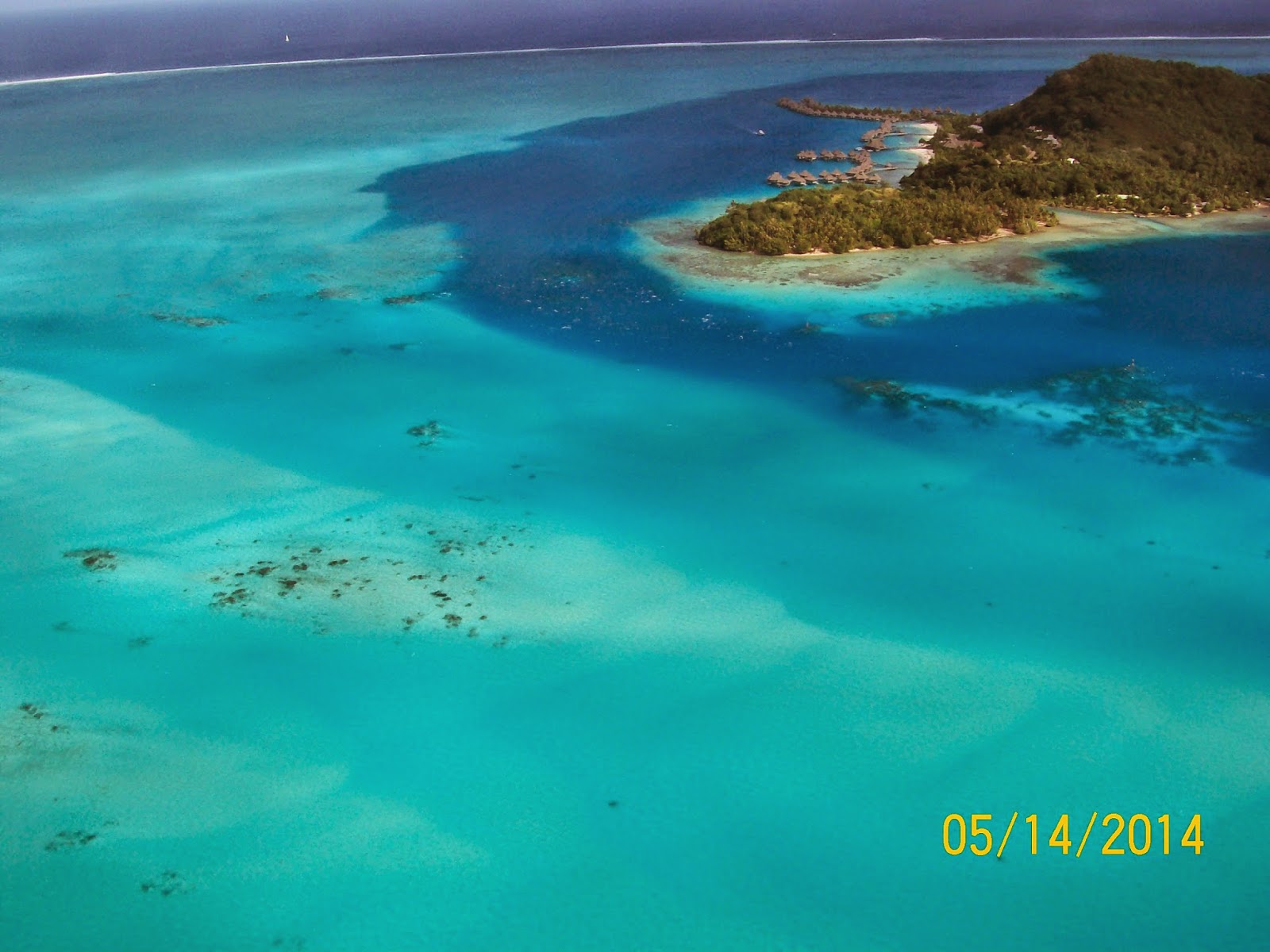We took off at it wasn't long before we were over the sea. I will apologize for the quality of the photo's since we were in a helicopter and sometimes the light on the windows reflected things back.
The island in the distance is Raiatea. What I liked about this image is you can see how the coral reef gets built up and then trees start to grow on it to anchor it even more. http://en.wikipedia.org/wiki/Coral_reef.
(I'm curious if these would also be called barrier island, bars or shoals or is it right just to call them coral reefs. I also thought of barrier reef but wikipedia kept on directing me to coral reefs when I would search for that.)
This was looking directly down on a coral reef. you can see how quickly the drop off is and how deep blue the water gets.
Another image of a coral reef with a steep drop-off.

This is a good view of Teavanui Pass. That is the main channel that the boats can navigate into the lagoon area.
 |
| The lagoon around Bora Bora. |
Just look at the colors of the see. The light color is shallow water and the darker blue is deeper.
We flew toward an islet called Toopuaiti.
 |
| Toopuaiti an islet. near Bora Bora |
Another view of the coral reef that surrounds Bora Bora.
From best I can tell this is Motu Tofari and those U shaped things are huts that are part of a hotel.
Then she turned the chopper and I could see more of the main island. As you can see from the number of white roofs there are not a lot of people who live on the island. I've seen different figures and am not sure what the correct number but I feel its safe to say less than 10,000 live on 15.6 sq miles.
I was getting to see Mount Rufau (139 ft) at the tip and Mata Pupu (236ft).
Looking to the other side where they had a better view of the highest peak Otemanu (727 ft)
I was pleased when she turned the helicopter again and I got a better view of Otemanu.
Yes this was definitely a volcano ( http://en.wikipedia.org/wiki/Volcano ).
 |
| Otemanu (727 ft) on Bora Bora |
I got excited to see this feature on the volcano - it was a dike http://en.wikipedia.org/wiki/Dike_%28geology%29 .
I enjoyed looking at the volcanic rock and just wished I could be up closer to observe it better.
This is looking back on the dike. I knew I wouldn't have seen this if I wasn't in the helicopter since it was on the other side of the island where the main pass was.
Having the airport there helped orient me and figure out what I was see. The islet in the center is Motu Toopaeraro and to its right is Motu Ome. The Airstrip in on Motu Mute and I've heard it called different name and am not sure of its exact name.
I thought since we were going to be flying in a helicopter we'd be taking off from this air strip since its made Bora Bora so famous during World War II. i was wrong we took off from a soccer field gathering area.
 |
| The air strip on Motu Mute, Bora Bora |
I just thought these were so pretty and different to see. I just had to include a couple of shots of them from different angles.
The sail boat couldn't get any closer and i wondered if they had to wade into the shore line or if there was a raft or something that they could use as a tender to get to the shore.
Just look at how remote this location is for a hotel. I could understand why it has a reputation for being popular with the celebrities.
Motu Ahuha and the Teavanui Pass.
 |
| Motu Ahuha and the Teavanui Pass, Bora Bora. |
And before we could help it we were back to where we started. We were suppose to have a longer trip but the weather was bad that was coming and it was cut short.
Even though we were on the same helicopter ride what I was seeing and taking pictures of was totally different from what my spouses was. Normally he doesn't take a lot of pictures - he leaves that up to me. I was surprised he took as many as he did and they were just as good so I'm going to do another post of his images.
































No comments:
Post a Comment